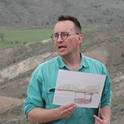Article
Plagioclase and Pyroxene Hosted Melt Inclusions in Basaltic Andesites of the Current Eruption of Arenal Volcano, Costa Rica
Journal of Volcanology and Geothermal Research
(2006)
Abstract
In this study, we investigated melt inclusions hosted in pyroxene and plagioclase to find direct evidence for the composition of melt components in the pre-eruptive magmas of the current eruption of Arenal volcano and to further shed light on the petrogenetic history of remarkably uniform basaltic andesitic bulk compositions.
Composition of melt inclusions ranges widely regardless of whether an inclusion is hosted by plagioclase or by pyroxene and whether crystals with inclusions came from tephra samples or from slower emplaced lava flows. However, inclusions from each type of host mineral have distinct evolutionary trends most consistent with being mainly introduced by post-emplacement crystallization of the enclosing host, which is also supported by the composition of groundmass glasses. At the least-modified compositions, plagioclase and pyroxene inclusion trends overlap allowing for identification of melt compositions entrapped by both phases and, thus, strongly suggesting that these melt compositions existed in the reservoir prior to entrapment. Most of these are “dacitic” (61 to 64 wt.% SiO2) and strongly match phenocryst-poor dacitic magmas of earlier eruptive phases of Arenal [Borgia, A., Poore, C., Carr, M.J., Melson, W.G., Alvarado, G.E., 1988. Structural, stratigraphic, and petrologic aspects of the Arenal–Chato volcanic system, Costa Rica: evolution of a young stratovolcanic complex. Bull Volcanol, 50, 86–105], suggesting earlier dacitic magmas may have been generated by melt-extraction processes. Correction for host crystallization of some inclusions also suggests that melt components as mafic as ∼ 53 wt.% may have been entrapped. All melt components inferred to have existed in the magmatic reservoirs prior to entrapment have low Mg# (38–45) yielding evidence for liquid compositions required for crystallizing the bulk of observed pyroxene and likely also olivine.
Water rich (> 5 wt.%, by difference) and probably undegassed (S = 400–1600 ppm, Cl = ∼ 2500 ppm) melt inclusions are found among inclusions from tephra. The close association of water-rich, dacitic melt inclusions with very anorthitic (85–91) plagioclase host compositions suggests that high An plagioclase may originate also from rather silicic liquids.
Furthermore, our study shows that melt inclusions from Arenal, even if only those that come from rapidly chilled tephra samples are considered, are complicated. They suggest rather multi-stage and complicated assembling scenarios for erupting bulk compositions during the current activity and likely for prior activities as well.
Keywords
- Melt inclusion,
- Post-entrapment crystallization,
- Volatiles,
- Mixed andesites,
- Anorthitic plagioclase
Disciplines
- Geology and
- Volcanology
Publication Date
September, 2006
Citation Information
Martin J. Streck. "Plagioclase and Pyroxene Hosted Melt Inclusions in Basaltic Andesites of the Current Eruption of Arenal Volcano, Costa Rica" Journal of Volcanology and Geothermal Research Vol. 157 Iss. 1-3 (2006) Available at: http://works.bepress.com/martin_streck/9/
